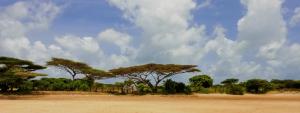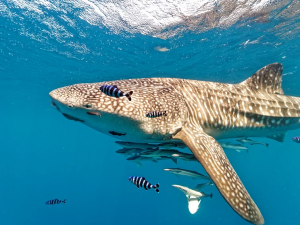
Grants
Marine Conservation
Protecting Marine Megafauna with Positive Eco Tourism Interactions
Year One Grant – KES 4,292,000 awarded
Project Length – 4 Years
Problem Statement
The project aims to address the environmental and conservation issue of protecting marine megafauna, including whale sharks, dolphins, sea turtles, and chondrichthyans (sharks and rays), in the coastal waters of Lamu.
These species are highly vulnerable to non-natural mortalities resulting from anthropogenic activities, especially fisheries and irresponsible tourism behaviours. By promoting responsible interactions, implementing evidence-based management strategies, and fostering community engagement, the project seeks to mitigate the threats posed to these species and their habitats.
The goal is to ensure the long-term survival and sustainability of marine megafauna while preserving the ecological integrity of the marine ecosystems they inhabit.
Project Summary
The project aims to establish a comprehensive framework for the conservation and sustainable management of marine megafauna in Lamu’s coastal waters. By addressing the threats posed by fisheries interactions and irresponsible tourism, we seek to protect species such as whales, dolphins, sharks, and sea turtles, which are highly vulnerable to non-natural mortalities resulting from anthropogenic activities.

Project Objectives
Enhance Fisheries Management
Collaborate with local fishing communities, Beach Management Units (BMUs), and government agencies to promote sustainable fishing practices and reduce bycatch of marine megafauna. This includes introducing selective fishing gear, conducting training sessions on responsible fishing techniques, and fostering dialogue for the development of fisheries regulations that prioritize conservation.
Promote Responsible Tourism
Raise awareness among tourists, tour operators, and other stakeholders about the importance of responsible interactions with marine megafauna. Develop and distribute guidelines for responsible wildlife viewing, including maintaining safe distances, avoiding direct contact, and minimizing underwater noise pollution. Conduct outreach programs, workshops, and media campaigns to educate visitors and encourage sustainable tourism practices.
Strengthen Community Engagement
Engage with local communities, including fishermen, youth groups, and schools, to foster a sense of ownership and responsibility towards marine megafauna conservation. Facilitate participatory workshops, training sessions, and capacity-building activities to empower community members as ambassadors for conservation. Establish partnerships with community-based organizations and facilitate their involvement in conservation initiatives.
Conduct Research and Monitoring
Implement a monitoring program to assess the population status, distribution, and behaviour of marine megafauna species in Lamu’s coastal waters. This includes collecting scientific data, conducting aerial and boat surveys, and utilizing photo-identification techniques. Collaborating with researchers, marine biologists, and academic institutions to contribute to the scientific understanding of these species and inform conservation strategies.
Strengthen Policy and Advocacy
Advocate for the integration of marine megafauna conservation into local and national policies, management plans, and environmental impact assessments. Engage with government agencies, NGOs, and other stakeholders to ensure the inclusion of conservation measures in coastal development projects. Participate in policy forums, conferences, and workshops to raise awareness about the conservation needs of marine megafauna and promote their protection.
Foster International Collaboration
Establish partnerships and collaborations with international organizations, research institutions, and conservation networks working on marine megafauna conservation. Share best practices, exchange knowledge, and leverage resources to enhance conservation efforts and strengthen the global conservation network for these species.

Specific Outcomes
From the implementation of the project, the following outcomes will be completed:
- Registration of tourist boats that interact with the megafauna.
- Create awareness among communities to positively engage with marine megafauna and actively protect it.
- Development of code of conduct for interactions with megafauna that is developed from community consultations, leading research, and best practices.
- Undertake research to understand current stocks and fishing capacities of Lamu’s waters.
About the Organisation
The Lamu Marine Conservation Trust (LaMCoT) has been actively engaged in community projects since 1997. They have successfully collaborated with fishermen and ex-poachers on turtle protection and monitoring, worked with youth groups on waste management, and played a key role in environmental education programs in local schools for over 15 years. LaMCoT’s long-standing partnerships and influence in the community have established them as a resource centre and trusted organization in the region.
You can read more about LAMCOT on their website.
